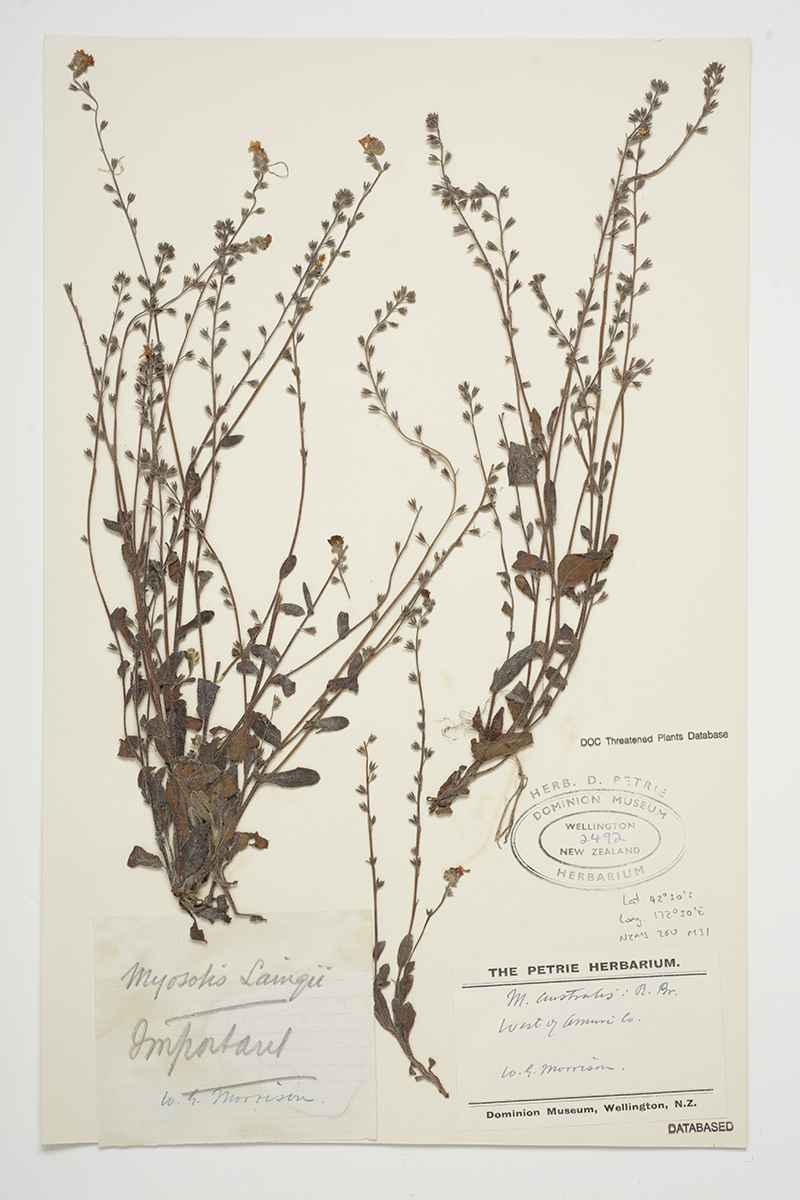Myosotis laingii Cheeseman (1912 "1911":67,161)
Waiautoa forget-me-not
Taxonomy & Nomenclature
Conservation Status
Extinct (de Lange et al., 2013:11; de Lange, 2014; Humphreys et al., 2019; Christenhusz & Govaerts, 2024; POWO, 2024)
Last record: 1912 (de Lange, 2014; Christenhusz & Govaerts, 2024)
IUCN RedList status: Extinct
Distribution
New Zealand
Biology & Ecology
Hypodigm
Museum of New Zealand Te Papa Tongarewa:
Media

Above: Myosotis laingii Cheeseman, collected West of Amuri Co., New Zealand. Acquisition history unknown. CC BY 4.0. Te Papa (SP002492)

Above: Myosotis laingii Cheeseman, collected West of Amuri Co., New Zealand. Acquisition history unknown. CC BY 4.0. Te Papa (SP002492)

Above: Myosotis laingii Cheeseman, collected Hawke's Bay, New Zealand. Acquisition history unknown. CC BY 4.0. Te Papa (SP002488)
References
Allan, H. H. (1961). Flora of New Zealand 1: 1-1085. R.E.Owen, Government Printer, Wellington.
Christenhusz, Maarten J. M. and Govaerts, Rafaël. (2023). Uitgestorven. Op plantenjacht rond de wereld: 1-511. Sterck & De Vreese.
Christenhusz, Maarten J. M. and Govaerts, Rafaël. (2024). Plant extinction in the Anthropocene. Botanical Journal of the Linnean Society. https://doi.org/10.1093/botlinnean/boae045 [Appendix S1]
de Lange, P. (2014). Myosotis laingii. The IUCN Red List of Threatened Species 2014: e.T62798327A62798331. https://dx.doi.org/10.2305/IUCN.UK.2014-2.RLTS.T62798327A62798331.en. Accessed on 02 July 2022.
de Lange, P. J., Rolfe, J. R., Champion, P. D., Courtney, S. P., Heenan, P. B., Barkla, J. W., Cameron, E. K., Norton, D. A. and Hitchmough, R. A. (2013). Conservation status of New Zealand indigenous vascular plants, 2012. New Zealand Threat Classification Series 3. Department of Conservation, Wellington. 70 pp.
Humphreys, Aelys M., Govaerts, Rafaël, Ficinski, Sarah Z., Lughadha, Eimear Nic and Vorontsova, Maria S. (2019). Global dataset shows geography and life form predict modern plant extinction and rediscovery. Nature Ecology & Evolution 3: 1043-1047. https://doi.org/10.1038/s41559-019-0906-2 [Supplementary Dataset 1]
Le Roux, Johannes J., Hui, C., Castillo, M. L., Iriondo, J. M., Keet, J.-H., Khapugin, A. A., Médail, F., Rejmánek, M., Theron, G. Yannelli, F. A. and Hirsch, H. (2019). Recent Anthropogenic Plant Extinctions Differ in Biodiversity Hotspots and Coldspots. Current Biology 29(17): 2912-2918.e2. https://doi.org/10.1016/j.cub.2019.07.063
POWO. (2024). Plants of the World Online (online resource). Facilitated by the Royal Botanic Gardens, Kew, United Kingdom. Available at: https://powo.science.kew.org/ [Accessed 24 April 2024]
W.C.M.C. (1996). Threatened plant database of the World Conservation Monitoring Centre. W.C.M.C., Cambridge, U.K.
Wilton, A.D.; Schönberger, I.; Boardman, K.F.; Breitwieser, I.; Cochrane, M.; Dawson, M.I.; de Lange, P.J.; de Pauw, B.; Fife, A.J.; Ford, K.A.; Gibb, E.S.; Glenny, D.S.; Heenan, P.B.; Korver, M.A.; Novis, P.M.; Redmond, D.N.; Smissen, R.D.; Tawiri, K. (2016). Checklist of the New Zealand Flora – Seed Plants. Lincoln, Manaaki Whenua-Landcare Research. http://dx.doi.org/10.7931/P1PP42
